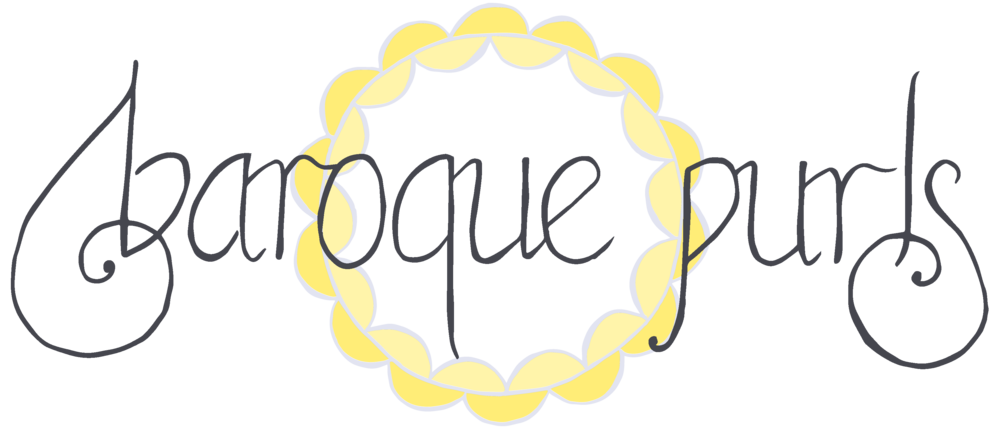This pair of patterns has been almost a year in the making, and my obsession with stranded colourwork is still going strong! The Orfeo Hat & Cowl feature colourwork inspired by the decorative stamped motifs found in seventeenth-century books and music scores. I enjoy spotting all the little decorative elements when I’m looking through an old music score, finding something new to sing or checking a detail of an old favourite, and when I find a motif that has knitting-design potential I do a quick sketch and make a note of where I found it. The IMSLP database is a fantastic treasure trove of public-domain music scores, and it’s where I go to find most of my sheet music these days.
Warning: more music-historical geekiness ahead!
The motifs I used as the starting point for my Orfeo Hat & Cowl come from some early editions of music by Claudio Monteverdi, one of my top two favourite composers (the other is J.S. Bach). The same tiny, tiling motifs appear on the title page of Monteverdi’s opera L’Orfeo (1609) and his Vespro della Beata Vergine (1610), which were both published by Venetian music printer Ricciardo Amadino. You can see the motifs below, forming the border of a page.
Motifs which can be combined in various different configurations are brilliant for creating a stitch pattern, and the shape of these reminds me of elaborate lyres or c-clefs. To create my colourwork pattern I traced enlarged versions of the motifs onto squared paper and added clean straight lines to contain them. To me, the contrast between the elements creates movement and drama, and feels very baroque.
The yarn I chose for my samples is Outlaw Yarn’s Bohemia Sport (45% Polwarth, 45% Alpaca, 10% Possum; 183yds/167m per 50g skein). When I was still at the swatching stage for these designs I asked around on Instagram for recommendations for good yarn for stranded colourwork, and I’m glad I went with this suggestion. It’s soft and warm, the fuzzy halo helps the stitches ‘mesh’ well without obscuring the design, and it can be worked at a tight gauge, which is how I prefer my colourwork.
I used half a skein of each colour for the hat, and a little over one skein of each colour for the cowl - so if you’d like a matching set, two skeins of each colour will be plenty. The colours I picked are Parchment for the hat’s main/background colour (MC), Gaslight for the cowl’s MC, and Leadlight for the contrast/motif colour (CC) for both. Leadlight has unfortunately been discontinued since I knit my two samples, but the new colour Erebus is a great substitute - it’s a dark blue/charcoal shade, whereas Leadlight was plain black.
I chose the Twisted German Cast On for both the hat and cowl because it’s quite substantial as well as stretchy, but you can use any cast on you prefer for 1x1 ribbing, e.g. Tubular, Long Tail, Alternate Cable, etc. I used this tutorial to remind myself how to work the Twisted German method: Photo Tutorial: Twisted German / Old Norwegian Cast-On.
Once you get into the colourwork, there will be some rounds with longer floats which you will need to ‘trap’ on the reverse side. I found a few good tutorials for this, including Andrea Rangel’s Catching Floats in Colorwork, Dianna Walla’s trapping long floats in stranded colorwork, and Ann Kingstone’s Trapping Floats. It does interrupt the flow of your knitting, but I feel it’s worth it to tidy up the long floats so they won’t snag on things and pull your stitches out of place.
Orfeo Hat features:
a stranded colourwork beanie knit in the round from the bottom up
swirling colourwork motifs which grow out of the corrugated ribbing of the brim, and simpler abstract colourwork in the crown shaping
hat dimensions: 18”/46cm circumference and 8.5”/21.5cm length, to fit adult head sizes ranging from 19-22”/48-56cm head circumference
requires 101yds/92.5m of the main/background colour (MC) + 102yds/93.5m of the contrast/motif colour (CC) in sport- or fingering-weight yarn
pattern includes charted stitch patterns only.
Orfeo Cowl features:
a stranded colourwork cowl knit in the round from the bottom up
swirling colourwork motifs edged with corrugated ribbing
cowl dimensions: 27”/68.5cm circumference and 10”/25.5cm height
requires 216yds/197m of the main/background colour (MC) + 209yds/191m of the contrast/motif colour (CC) in sport- or fingering-weight yarn
pattern includes charted stitch patterns only.
The Orfeo Hat and Orfeo Cowl patterns are available on Ravelry and Payhip, both individually and as an ebook (with a reduced price per pattern).








